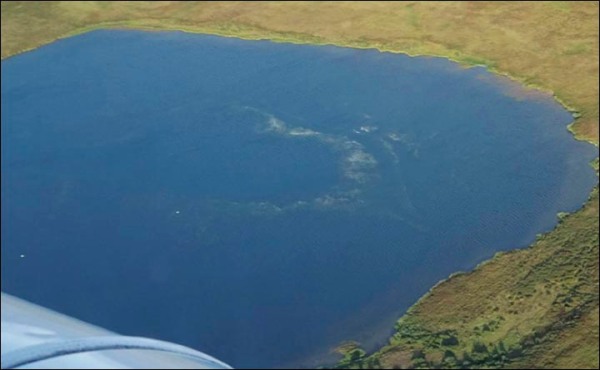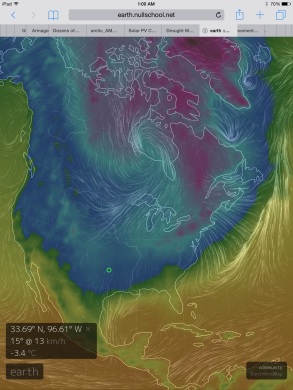Siberian
Permafrost Methane Shows Growing Eruption: Number of Global
Warming-Induced Craters Now Estimated at 20-30
24
February, 2015
(Siberian methane crater locations. In total, 7 methane blow holes with features similar to the Yamal Crater have now been discovered. Unofficial reports from observers on the ground have local scientists placing the likely count now at between 20-30 original craters with many more secondary craters. Image source: The Daily Mail.)
* * * * *
The
ground smoked for hours. Then, with a great flash and an enormous
boom, the land exploded. When the smoke cleared, all that was left
was a great, black hole. Ejected earth lay scattered around it —
sheer sides plunging into the permafrost like some gigantic, gaping
gun barrel.
This
was the scene last summer in Yamal, Siberia — a region of extreme
northern Russia.
Mysterious
Holes Emitting Methane Gas
Speculation
about the cause of this mysterious hole became rampant. It looked
like a sink hole, except for the ejected material surrounding it.
Some said it was a pingo. But pingos weren’t known to form due to
explosions.
Teams
of scientists rapidly descended upon the hole. And there they found
high readings of methane at the hole’s base — in the range of 10%
concentration, which is a very explosive level for the gas. At the
base of the hole they also found evidence of hydrate. A form of
frozen water-methane that is quite unstable unless kept under high
pressure and low temperature.
The
initial conclusion of the Russian scientists was that relic hydrate
sealed beneath the previously flooded Siberian permafrost had been
destabilized. Eventually reaching an explosive concentration, it then
erupted from the ground.
Discovery
of this methane crater spurred a sweep of the area. Almost
immediately, two other craters with similar features were discovered.
And throughout fall and winter, both ground searches and satellite
reconnaissance identified still more.
(Newly discovered methane blow-hole found by satellite observation. In the top frame we see tundra absent the newly formed hole. In the bottom frame, we find the hole forming a lake [B2] surrounded by 20 or more ‘baby craters.’ Image source: The Siberian Times.)
Now,
according to recent reports in the Siberian Times, a total of seven
craters with features similar to the Yamal eruption have been
pinpointed by observers. Just one of these craters (shown above)
hosted about 20 smaller ‘baby craters’ surrounding it. In this
instance, a large methane store below the permafrost is thought to
have explosively displaced a shot-gun pattern of frozen soil sections
before filling with water.
Most
of the craters, like the one above, were observed to rapidly fill
with water even as they continued to emit methane. In many instances,
the methane emission was visible as bubbles on the newly formed lake
surface.
(Bubbles from suspected methane crater lake as seen by an observation aircraft. Image source: The Siberian Times.)
Additional
reports from reindeer herders have led these same scientists to
believe that in the range of 20-30 of these methane eruption holes
are likely to exist in this region of Northwestern Siberia.
A
Problem of Relic Hydrates Facing Rapid Warming
The
fact that reindeer herders keep discovering new holes and that the
first Yamal craters discovered earlier this year were recent events
have led local scientists to believe that the eruptions are a new
phenomena for Siberia. There, temperatures have warmed by a stunning
2 degrees Celsius within the mere span of 14 years. A very rapid rate
of warming that is putting severe stress on the geophysical stability
of this Arctic region.
Last
night, as polar amplification again ramped up, we saw an example of
this very rapid warming with locations in Yamal, Russia experiencing
-3.1 C temperatures as of 1 AM Eastern Standard Time. A very warm
measure for this region during winter time — representing an
anomaly at least 20 degrees Celsius above average. For reference,
North Texas, an area far south of the Arctic Circle, experienced
similar readings (-3.4 C) at the same time:
(Side-by-side frames showing 1 AM EST temperatures in Yamal Russia [left frame] and North Texas, US [right frame]. Location in the frames is indicated by the small green circle. Temperature, wind speed and direction, and grid location are given in the lower left hand corner. Image source: Earth Nullschool. Data Source: Global Forecast Systems Model.)
In
other words, it was colder in North Texas last night than it was in
Yamal, Siberia near the 70 degree North Latitude line beside the
Arctic Ocean.
This
extremely rapid warming is thought by Russian scientists to have
destabilized zones of relic hydrate trapped beneath the permafrost.
There, the methane gas bonded with water to form a kind of methane
ice.
Sandwiched
beneath frozen permafrost, the hydrate remains stable so long as
temperatures and pressures are relatively constant. Any increase in
warmth — either through geological processes working below the
hydrate, or from changes at the surface causing permafrost to melt
and warmer, liquid water to contact the hydrate — would result in
increased hydrate instability.
(The Yamal Crater as seen by Russian Scientists who investigated the scene last summer. The crater’s structure and surrounding ejecta was indicative of an explosive outburst. Image source: The Siberian Times.)
In
some cases, the gas would very rapidly liberate from its frozen traps
forming increasingly high pressure pockets beneath the permafrost. If
these pockets reach 10 percent methane concentration, they become
very explosive and can be ignited when in contact with a catalyst or
ignition source. The result, either due to very high pressure or
ignition, is plugs of permafrost exploding from the ground as the gas
erupts to the surface.
Conditions
in Context
It
is important to note that the amount of methane liberated by these
initial eruption events is likely rather small — when considered on
the global scale. However, what we see in Siberia now may be part of
a growing and ominous trend.
First,
we do not know the size of the potential methane store that could be
liberated in such an explosive fashion. And the question must be
asked — if we are looking at such rapid warming of methane hydrates
in shallow sea and former shallow sea regions, what scale eruptions
could we potentially experience in the future? Could very large
sections of hydrate go critical? Areas possibly covering hundreds or
thousands of square meters or more?
The
Russian scientists seem very concerned. And, ironically, it is for
the future safety of their oil and gas infrastructure, which sits
atop what is potentially a rapidly destabilizing zone. A zone that
could see explosive eruptions of the ground beneath pipes, equipment
and extraction fields. (One would think that the Russians would also
begin questioning the continued exploration and production of oil and
gas considering its contribution to the dangers they are now
identifying. But that level of wisdom appears absent in the recent
assessments.)
Second,
it appears that these methane eruptions provide pathways for ongoing
release. Not all of the gas in the relic hydrate is initially
liberated. And the structures that remain apparently release methane
gas for some time — as is evidenced by continued high methane
concentrations found at crater sites and by observed emissions from
crater lake surfaces.
In
essence, if this is a growing trend, then it is a rather unsettling
one. Especially when one considers that it is just a single instance
of many possible amplifying carbon feedbacks set off by a very rapid
human warming. Particularly, the explosive land and ocean
floor-altering nature of this specific carbon feedback makes it
especially troubling. For it encompasses the very nature of a
catastrophic upheaval.
In
the end, the question must be asked — is Siberia sitting atop a
methane volcano that is being prodded to rapid wakening by
high-velocity human warming?
Links:
Hat
Tip to Wili
Hat
Tip to Colorado Bob









No comments:
Post a Comment
Note: only a member of this blog may post a comment.